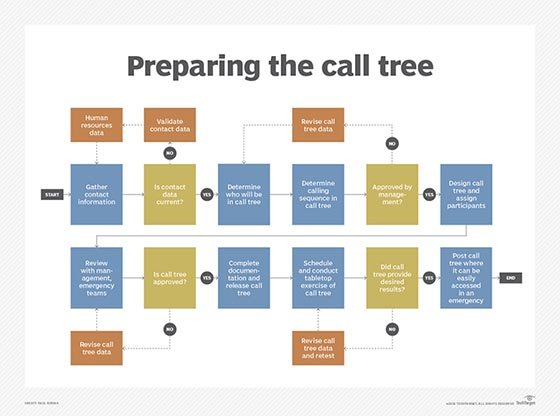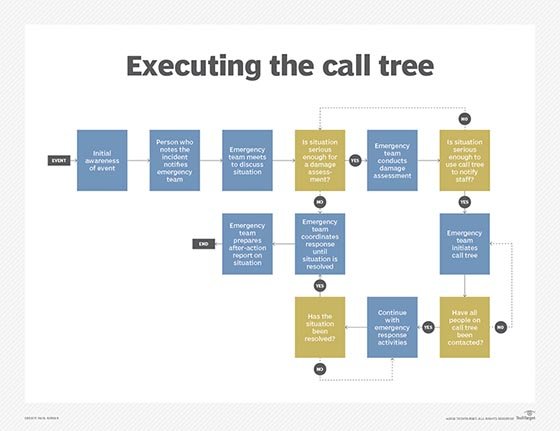call tree
A call tree is a layered hierarchical communication model that is used to notify specific individuals of an event and coordinate recovery, if necessary. A call tree is also known as a phone tree, call list, phone chain or text chain.
Call trees play an important role in disaster recovery plans. They can be automated with software that contacts individuals using a landline, email, cellphone, text message or another type of communication. Smaller organizations will often use a manual call tree in which each person who receives a call is responsible for calling others in the tree.
The team creating the call tree coordinates data gathering with human resources, as contact data typically come from that department. Each listed employee may have several contacts, including office, home and cellphone numbers, and an email address. The list of contacts, and sequence of notification, is then approved by the emergency management team and company management. The emergency call tree should be available in several locations -- such as the company Intranet and in hard-copy format -- and someone should keep the information up to date.

In terms of format, the call tree can exist as a simple worksheet with a tabular structure, listing who calls whom.
How call trees work
During an incident, the call tree is initiated once the emergency management team has completed its assessment and determined that employees must be notified.
One employee is designated to launch the emergency call tree. An organization should have an alternate call tree lead in the event the original lead is not available.
As the call tree progresses, members should take notes on people they can't reach, as that data must be relayed back to the emergency team for follow-up.
To ensure calls were completed as planned, the last person on the list should confirm receipt of the final call to a designated employee. Another designated employee can serve as the communication list manager to monitor responses and contact backup staff as necessary.

Once the entire call tree has been notified, other business continuity plan procedures can proceed. Call tree benefits include human interaction, the ability to relay important information and the creation of a comprehensive list of employee contact information.
Automated vs. manual call trees
In manual cases, each person on the call tree contacts the next person on the list and so on, until everyone has been contacted. In the event the next person on the list cannot be reached, the caller continues with the next level of the phone tree so the chain does not break.
The manual call tree procedure, while often simple and effective, may not be scalable and could take too long if there are a large number of employees who need to be contacted. To address this limitation, there is an automated method that allows business continuity managers to record a voice message that is broadcast to employees. During this call, a manager can configure the system to receive input from users, such as "Press 2 if you need any assistance."
Because the automated method places calls simultaneously, this can help to reduce or eliminate possible breaks in the emergency call tree. The systems can keep track of all calls made and the responses received.
Emergency notification systems can have two forms:
- in-house devices that generate outgoing messages to contacts stored in databases; and
- managed services in which the user accesses the emergency notification system through a phone call or the internet.
Call tree software is now available from vendors such as AtHoc, Everbridge, MIR3, One Call Now and Send Word Now.
An emergency communications plan may include both an automated notification system and a traditional landline tree in case internet or cellular service is disrupted.
Call tree testing
The phone tree can be tested by doing a walk-through in a conference room or another office location. This process ensures everyone knows what to do when the emergency call tree is initiated, confirms the call tree procedure works according to plan and validates that contact information is correct.
Call tree testing guidelines include:
- asking designated callers to ask recipients to confirm other contact numbers;
- recording the start and end time of the call tree exercise to figure out how long it takes;
- making the necessary corrections regarding contact information; and
- creating records for audit purposes.
A testing exercise provides a critical check of the call tree procedure in the event of an incident. A company can complete call tree testing on its own or perform it as part of a full-scale disaster recovery test.
History of the call tree and its improvements
At one time, a manual call tree may have been the only option available to organizations due to technological limitations. But a phone-only tree is not as sustainable as it used to be. For example, cellphone coverage can be lost during an emergency, and employees use a variety of devices and media to communicate information. For example, a text message may be an easier way to reach someone than a phone call.
Automated call tree software options have increased in recent years. Functionalities beyond emergency notification include:
- conference calls
- person-to-person communication
- message center
- customer notification
- progress reporting
- employee reporting
- text-to-speech messaging






